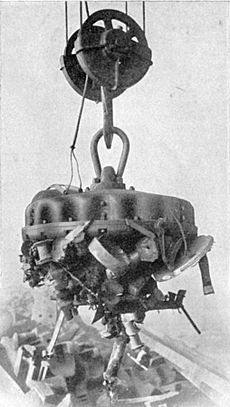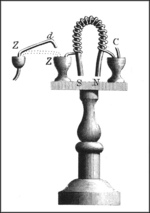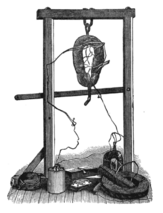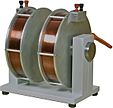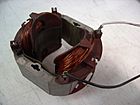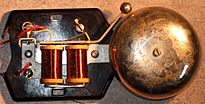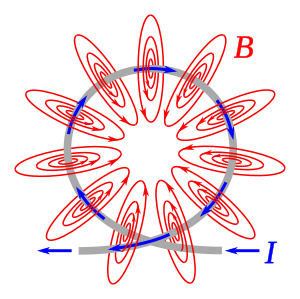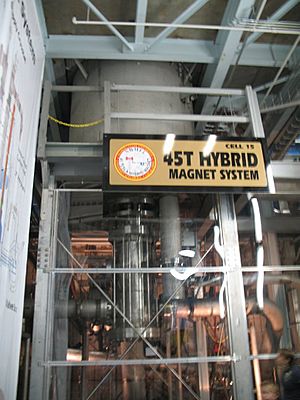Electromagnet facts for kids
An electromagnet is a type of magnet in which the magnetic field is produced by an electric current. Electromagnets usually consist of wire wound into a coil. A current through the wire creates a magnetic field which is concentrated in the hole in the center of the coil. The magnetic field disappears when the current is turned off. The wire turns are often wound around a magnetic core made from a ferromagnetic or ferrimagnetic material such as iron; the magnetic core concentrates the magnetic flux and makes a more powerful magnet.
The main advantage of an electromagnet over a permanent magnet is that the magnetic field can be quickly changed by controlling the amount of electric current in the winding. However, unlike a permanent magnet that needs no power, an electromagnet requires a continuous supply of current to maintain the magnetic field.
Electromagnets are widely used as components of other electrical devices, such as motors, generators, electromechanical solenoids, relays, loudspeakers, hard disks, MRI machines, scientific instruments, and magnetic separation equipment. Electromagnets are also employed in industry for picking up and moving heavy iron objects such as scrap iron and steel.
Large electromagnets are usually powered by variable current electronic power supplies, controlled by a microprocessor, which prevent voltage spikes by accomplishing current changes slowly, in gentle ramps. It may take several minutes to energize or deenergize a large magnet.
Some large electromagnets require water cooling systems in the windings to carry off the waste heat.
Contents
History
British scientist William Sturgeon invented the electromagnet in 1824. His first electromagnet was a horseshoe-shaped piece of iron that was wrapped with about 18 turns of bare copper wire (insulated wire didn't then exist). The iron was varnished to insulate it from the windings. When a current was passed through the coil, the iron became magnetized and attracted other pieces of iron; when the current was stopped, it lost magnetization. Sturgeon displayed its power by showing that although it only weighed seven ounces (roughly 200 grams), it could lift nine pounds (roughly 4 kilos) when the current of a single-cell power supply was applied. However, Sturgeon's magnets were weak because the uninsulated wire he used could only be wrapped in a single spaced out layer around the core, limiting the number of turns.
Beginning in 1830, US scientist Joseph Henry systematically improved and popularised the electromagnet. By using wire insulated by silk thread, and inspired by Schweigger's use of multiple turns of wire to make a galvanometer, he was able to wind multiple layers of wire on cores, creating powerful magnets with thousands of turns of wire, including one that could support 2,063 lb (936 kg). The first major use for electromagnets was in telegraph sounders.
Applications of electromagnets
A portative electromagnet is one designed to just hold material in place; an example is a lifting magnet. A tractive electromagnet applies a force and moves something.
Electromagnets are very widely used in electric and electromechanical devices, including:
- Motors and generators
- Transformers
- Relays
- Electric bells and buzzers
- Loudspeakers and headphones
- Actuators such as valves
- Magnetic recording and data storage equipment: tape recorders, VCRs, hard disks
- MRI machines
- Scientific equipment such as mass spectrometers
- Particle accelerators
- Magnetic locks
- Magnetic separation equipment, used for separating magnetic from nonmagnetic material, for example separating ferrous metal from other material in scrap.
- Industrial lifting magnets
- magnetic levitation, used in a maglev train or trains
- Induction heating for cooking, manufacturing, and hyperthermia therapy
Simple solenoid
A common tractive electromagnet is a uniformly-wound solenoid and plunger. The solenoid is a coil of wire, and the plunger is made of a material such as soft iron. Applying a current to the solenoid applies a force to the plunger and may make it move. The plunger stops moving when the forces upon it are balanced. For example, the forces are balanced when the plunger is centered in the solenoid.
Some improvements can be made on the basic design. The ends of the stop and plunger are often conical. For example, the plunger may have a pointed end that fits into a matching recess in the stop. The shape makes the solenoid's pull more uniform as a function of separation. Another improvement is to add a magnetic return path around the outside of the solenoid (an "iron-clad solenoid"). The magnetic return path, just as the stop, has little impact until the air gap is small.
Physics
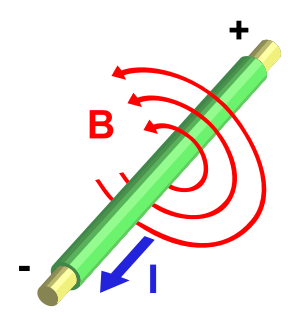
An electric current flowing in a wire creates a magnetic field around the wire, due to Ampere's law (see drawing below). To concentrate the magnetic field, in an electromagnet the wire is wound into a coil with many turns of wire lying side by side. The magnetic field of all the turns of wire passes through the center of the coil, creating a strong magnetic field there. A coil forming the shape of a straight tube (a helix) is called a solenoid.
The direction of the magnetic field through a coil of wire can be found from a form of the right-hand rule. If the fingers of the right hand are curled around the coil in the direction of current flow (conventional current, flow of positive charge) through the windings, the thumb points in the direction of the field inside the coil. The side of the magnet that the field lines emerge from is defined to be the north pole.
Much stronger magnetic fields can be produced if a "magnetic core" of a soft ferromagnetic (or ferrimagnetic) material, such as iron, is placed inside the coil. A core can increase the magnetic field to thousands of times the strength of the field of the coil alone, due to the high magnetic permeability μ of the material. This is called a ferromagnetic-core or iron-core electromagnet. However, not all electromagnets use cores, and the very strongest electromagnets, such as superconducting and the very high current electromagnets, cannot use them due to saturation.
High-field electromagnets
Superconducting electromagnets
When a magnetic field higher than the ferromagnetic limit of 1.6 T is needed, superconducting electromagnets can be used. Instead of using ferromagnetic materials, these use superconducting windings cooled with liquid helium, which conduct current without electrical resistance. These allow enormous currents to flow, which generate intense magnetic fields. Superconducting magnets are limited by the field strength at which the winding material ceases to be superconducting. Current designs are limited to 10–20 T, with the current (2017) record of 32 T. The necessary refrigeration equipment and cryostat make them much more expensive than ordinary electromagnets. However, in high power applications this can be offset by lower operating costs, since after startup no power is required for the windings, since no energy is lost to ohmic heating. They are used in particle accelerators and MRI machines.
Bitter electromagnets
Both iron-core and superconducting electromagnets have limits to the field they can produce. Therefore, the most powerful man-made magnetic fields have been generated by air-core nonsuperconducting electromagnets of a design invented by Francis Bitter in 1933, called Bitter electromagnets. Instead of wire windings, a Bitter magnet consists of a solenoid made of a stack of conducting disks, arranged so that the current moves in a helical path through them, with a hole through the center where the maximum field is created. This design has the mechanical strength to withstand the extreme Lorentz forces of the field, which increase with B2. The disks are pierced with holes through which cooling water passes to carry away the heat caused by the high current. The strongest continuous field achieved solely with a resistive magnet is 41.5 tesla as of 22 August 2017[update], produced by a Bitter electromagnet at the National High Magnetic Field Laboratory in Tallahassee, Florida. The previous record was 37.5 T. The strongest continuous magnetic field overall, 45 T, was achieved in June 2000 with a hybrid device consisting of a Bitter magnet inside a superconducting magnet.
The factor limiting the strength of electromagnets is the inability to dissipate the enormous waste heat, so more powerful fields, up to 100 T, have been obtained from resistive magnets by sending brief pulses of high current through them; the inactive period after each pulse allows the heat produced during the pulse to be removed, before the next pulse.
Definition of terms
| Term | Significance | Unit |
|---|---|---|
 |
cross sectional area of core | square meter |
 |
Magnetic field (Magnetic flux density) | tesla |
 |
Force exerted by magnetic field | newton |
 |
Magnetizing field | ampere per meter |
 |
Current in the winding wire | ampere |
 |
Total length of the magnetic field path  |
meter |
 |
Length of the magnetic field path in the core material | meter |
 |
Length of the magnetic field path in air gaps | meter |
 |
Pole strength of the electromagnet | ampere meter |
 |
Permeability of the electromagnet core material | newton per square ampere |
 |
Permeability of free space (or air) = 4π(10−7) | newton per square ampere |
 |
Relative permeability of the electromagnet core material | dimensionless |
 |
Number of turns of wire on the electromagnet | dimensionless |
 |
Distance between the poles of two electromagnets | meter |
See also
 In Spanish: Electroimán para niños
In Spanish: Electroimán para niños


